
by Contributed | Jul 13, 2023 | Technology
This article is contributed. See the original author and article here.
Like you, professionals around the world know that the cloud is transforming the business landscape for the better, while offering unparalleled opportunities for innovation and growth. As you look to the cloud to do more with less and to help support your organization’s goals and success, we’re confident that Azure can help you do exactly that—from saving money by migrating your apps and data to the cloud, to optimizing those cloud costs, and then reinvesting those savings to drive progress.
Knowing how critical these areas are, our mission is for Azure to be the world’s computer, so you can do what you do best—innovate, create, and differentiate your business. We also know that you need to focus on strategy and decision-making rather than on navigating the technical complexities of the cloud, even while you explore Azure costs and benefits, along with its ability to help solve your organization’s challenges.
So, where can you find an Azure overview?
We’re happy to introduce the new Get to know Microsoft Azure cloud platform: An overview for business professionals learning path on Microsoft Learn, crafted with you and your learning goals, needs, and preferences in mind. This free practical resource is designed to bridge the gap between cloud platform knowledge and business strategy—with no technical background required. Plus, you can complete it in about 90 minutes, which makes this an extremely time-efficient investment.
Created to help you quickly learn the advantages of Azure and how it can support your organization’s success, this learning path focuses on real-world examples across multiple industries. It demonstrates how cloud adoption can benefit your operations, drive cost savings, fuel growth, and more.
What can you expect to learn?
We know that business leaders want the innovation and agility that the cloud enables, but you need to learn at your own pace and on your own schedule. So we’ve distilled the essential aspects of Azure into concise modules, helping you to get the maximum value from your time. With practical insights and real-life case studies, we highlight the transformative power of cloud adoption, offering the inspiration and confidence to explore the possibilities of Azure in three modules:
- Describe the basics of Azure cloud for business details what the cloud is, what Azure is, and how your business can grow and transform with Azure and cloud economics.
- Describe the business benefits of Azure covers cost efficiency, innovation, agility, and security.
- Transition your business to Azure examines the various decisions to anticipate as you move to the cloud. Review strategic considerations and best practices for migrating to Azure and look ahead to the Microsoft Cloud Adoption Framework.
 Modules and lessons included in the “Get to know Microsoft Azure cloud platform: An overview for business professionals” learning path
Modules and lessons included in the “Get to know Microsoft Azure cloud platform: An overview for business professionals” learning path
What other new learning paths are available for business leaders?
Like the cloud, AI has the power to change how organizations around the world operate, compete, and build value. And AI is ushering in a transformative era of innovation, efficiency, and unprecedented possibilities. We recently announced another new free educational series on Microsoft Learn, Transform Your Business with Microsoft AI, created to help you build your AI knowledge, insights, and skills.
This curriculum, which complements the new Azure overview for business leaders, explores:
- The competitive advantage and potential of AI.
- How to make informed decisions about its adoption.
- Examples from the Microsoft AI journey.
- Guidance from Microsoft experts and other industry leaders.
With an emphasis on responsible AI, including ethics, fairness, transparency, and accountability, this learning path aims to empower organizations of all sizes to harness the potential of AI. For more details, read AI for business leaders: Discover AI advantages in this Microsoft AI learning series.
Make the most of the new Azure training
When you take this 90-minute cloud journey, you gain insight into the transformative power of Azure, enhancing your cloud fluency and examining strategic decisions that can help drive your business forward. With Microsoft Azure as your trusted cloud provider, you get not only security and privacy but also a reliable business partner invested in your success. Embrace the benefits of cloud computing, explore how it can solve your challenges, and discover the potential savings it offers, with this new learning path for business leaders.

by Contributed | Jul 12, 2023 | Technology
This article is contributed. See the original author and article here.
We’re excited to share the public preview of restricted management administrative units, a new role-based access control (RBAC) feature in Microsoft Entra ID.
What you can do with restricted management administrative units
With restricted management administrative units, you can now designate specific users, security groups, or devices in your Microsoft Entra ID tenant that you want to protect from modification by tenant-level administrators.
Here are some situations in which this is useful:
- You want to protect sensitive user accounts, such as C-level executives, from being able to have their password or multifactor authentication settings changed by regular helpdesk administrators.
- You want to ensure that certain user accounts, security groups, or devices from a specific country can only be modified by designated administrators from that country.
- You have specific security groups granting access to sensitive data and you want to restrict who can modify the membership only to a small set of administrators.
By placing your sensitive objects in a restricted management administrative unit, your tenant-level administrators will not be able to modify them. Only the administrators you explicitly assign to the scope of the administrative unit itself will be able to make changes.
 Tenant-scoped and other admin unit-scoped administrators are blocked from resetting executives’ account passwords. Only the explicitly designated Executive admin can manage these accounts.
Tenant-scoped and other admin unit-scoped administrators are blocked from resetting executives’ account passwords. Only the explicitly designated Executive admin can manage these accounts.
This is a much easier way to protect your sensitive objects than having to identify and scope every single role assignment in the tenant just to your non-sensitive objects.
How to use restricted management administrative units in your tenant
Here’s a quick example of how restricted management administrative units make it a breeze to secure a few sensitive user accounts in your tenant:
1. Under Roles & admins, select Admin units and click Add to create a new administrative unit.
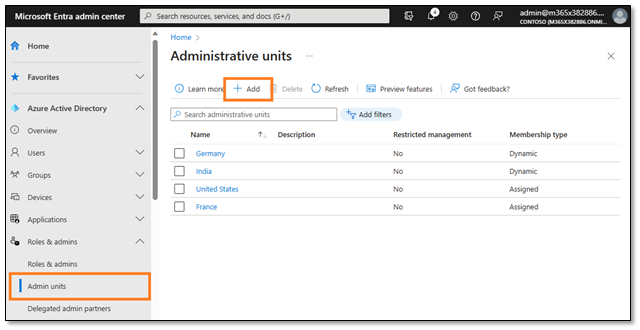
2. Set the Restricted management administrative unit setting to “Yes” and click Next: Assign Roles
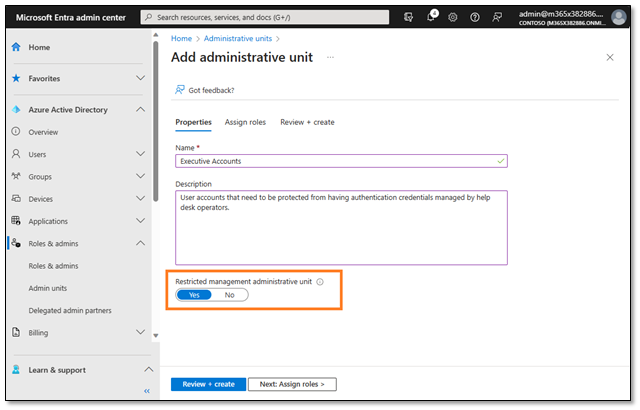
3. Add the designated administrator(s) who should be the helpdesk administrators for these sensitive accounts (these are the people who you do want to manage the accounts) and finish creating the administrative unit.
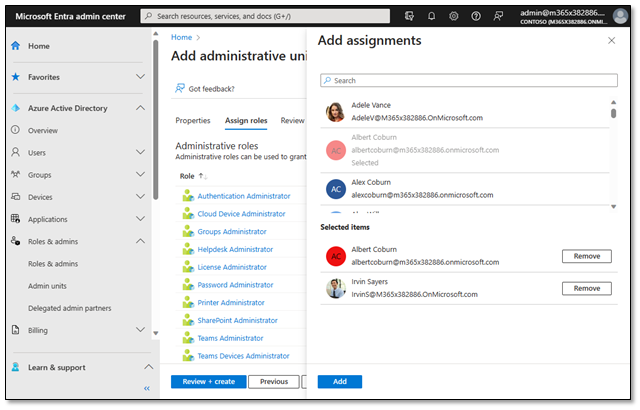
4. Now, you can go ahead and add the sensitive user accounts to the restricted management administrative unit you just created (just like you would for any other administrative unit).
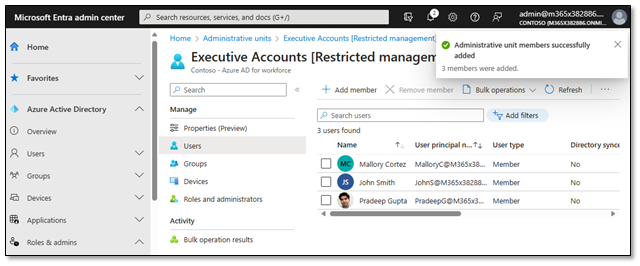
That’s it! Now the sensitive user accounts can only be modified by the users you designated, regardless of how many other administrative roles may be assigned in your tenant.
To learn more details about how restricted management administrative units can help you secure sensitive resources in your tenant, check out our product documentation!
Best Regards,
Stuart Kwan
Partner Manager, Product Management
Microsoft Identity Division
Learn more about Microsoft identity:
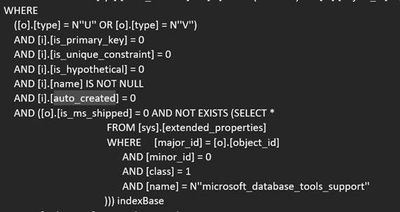
by Contributed | Jul 11, 2023 | Technology
This article is contributed. See the original author and article here.
In the realm of database management, the BACPAC format is widely used for exporting and importing data between databases. However, we have found an interesting service request, where the recommended automatic indexes are not included in the exported data used by BACPAC.
The Scenario:
During a remote session with a customer, a comparison between the source and target databases revealed a discrepancy in the indexes. Specifically, while the source database contained three types of indexes (PK_xxx, IX_xxx, and NCI_xxx), only the manually created PK_xxx and IX_xxx indexes were visible in the target database after restoration. The absence of NCI_xxx indexes prompted an investigation into the BACPAC export process.
Unveiling the Missing Indexes:
To shed light on the issue, the .BACPAC file extension was changed to .ZIP, allowing access to the model.xml file. By analyzing the file, a search for PK_xxx and IX_xxx indexes revealed their presence, but the NCI_xxx indexes were absent. Further examination of the sys.indexes view showed a significant distinction: the column auto_created held a value of 1 for NCI_xxx indexes, indicating that they were automatically created by Azure.

Uncovering the Export Query Condition:
A test conducted in an on-premises environment using SQL Profiler provided valuable insights. The query responsible for exporting indexes contained a condition wherein auto_created = 0, thereby excluding automatically created indexes. This finding explains the root cause of the missing NCI_xxx indexes in the BACPAC export.
Enjoy!

by Contributed | Jul 10, 2023 | Technology
This article is contributed. See the original author and article here.
Today, we are so excited to announce the general availability of Azure cross-region Load Balancer in all Azure public and national cloud regions. Since the preview, this product has been used by so many of you, our customers, whose valuable feedback has helped further improve the product. Our Global tier of Azure Load Balancer is ready for you to use in your production workloads. It is backed by the same 99.99% availability SLA.
Azure Load Balancer’s global tier is a cloud-native global network load balancing solution. With cross-region load balancer, you can distribute traffic across multiple Azure regions with ultra-low latency and high performance.

Key Features
Ultra-low Latency
Azure cross-region Load Balancer is optimized for ultra-low latency traffic distribution. This ultra-low latency is achieved through two mechanisms, geo-proximity routing and layer 4 distribution.
IP Controls
Each instance is given a static globally anycast IP address that you own and control. With a static IP address, you don’t have to worry about your frontend IP changing. In addition, cross-region load balancer preserves the original IP of the packet. The original IP is available to the code running on the virtual machine. This preservation allows you to apply logic that is specific to an IP address.
Ability to scale up/down behind a single endpoint.
When you expose the global endpoint of a cross-region load balancer to your end-users, you can add or remove regional deployments behind the global endpoint without interruption. This also enables easy scaling for high traffic events.
High Availability
Under a single global anycast IP, you can add all your application’s regional load balancers to achieve high availability. If one region fails, traffic is automatically routed to the closet healthy regional load balancer to a user, with no intervention from you. With automatic health probes and failovers, you can achieve high availability and regional redundancy for your applications.
What’s New
Azure Load Balancer’s Global tier provides the following additional capabilities as part of the general availability release:
SLA backing
Azure cross-region Load Balancer is now backed by a 99.99% availability SLA just like the regional tier. This means that you can count on the SLA for your production workloads.
UDP support
During preview, UDP traffic was not supported via Global tier Azure Load Balancer. With this release, UDP traffic is supported for IPv4.
Floating IP
You can also set up floating IP at the cross-region load balancer level. With floating IP, you can reuse backend ports across multiple frontend IP addresses and rules.
An example real world scenario
To better understand the use case of Azure’s cross-region Load Balancer, let’s explore an example customer scenario. In this scenario, we’ll learn about a customer, their use case, and how Azure Load Balancer came to the rescue.
Who is the customer?
In this scenario we will be learning about an example customer called Contoso. Contoso is a large utility company based out of North America. Contoso has over 6 million internet of things (IoT) devices spread across North America, Asia, and Europe. These IoT devices constantly send data back every hour to an application hosted on Azure. Contoso has deployed their applications into multiple Azure regions across all 3 continents, to support their low latency requirement. To support high availability at a regional level, Contoso places each instance of the application behind an Azure Load Balancer.
What are the issues with the customer’s current set-up?
By having the application deployed in multiple regions across the globe, Contoso’s IOT devices can send their data with low latency to the backend application. However, this set-up has led to a few issues that need to be dealt with as Contoso scales up their operation.
- First, each deployment of Contoso’s application is deployed with an Azure Load Balancer, and each load balancer has its own public IP address. Contoso needs to ensure that each IOT device is sending its data to the correct IP address. IP management and overhead is becoming a growing concern for Contoso as they are looking to expand into additional Azure regions.
- Second, in the off chance that an Azure region fails, then Contoso will need to manually failover all the affected IoT devices to the next available Azure region. Manually redirecting traffic isn’t a feasible solution for Contoso as they are looking to scale to over 10 million plus IoT devices in the next 4 years. They could add another product on top but do not want to incur the added complexity.
Given the concerns with their current set-up, Contoso is actively looking for a solution that provides a single IP address, multi-region support, and automatic fail-over in case a region is down.
How did Azure’s cross-region Load Balancer help?
Azure cross-region Load Balancer is a perfect solution to Contoso’s problems! With Azure cross-region Load Balancer, Contoso will get a single globally anycast IP address in which all the IoT devices can send their data. Contoso can add and remove backend regional load balancers with zero interruption to their operations. Also, cross-region load balancer provides automatic fail-over to the next available regional load balancer in the event that a regional load balancer is unhealthy. With this feature, Contoso no longer needs to manually fail-over impacted IoT devices during an incident, since high availability is achieved without any intervention required.
With all the benefits of Azure cross-region Load Balancer, the team at Contoso decided to integrate the product with their overall application. After running a small-scale test, Contoso rolled out Azure cross-region Load Balancer into full production and experienced the benefits immediately.
Learn More
Visit the Cross-region load balancer overview to learn more about Azure’s cross-region Load Balancer and how it can fit into your architecture.

by Contributed | Jul 10, 2023 | AI, Business, Collaborative apps, Microsoft 365, Microsoft Teams for ISVs, Technology
This article is contributed. See the original author and article here.
Since launching on Teams about four years ago, Moveworks has earned dozens of Fortune 500 customers by saving countless hours of employee time, making work more efficient, and reducing millions of dollars in IT support costs. Three key strategies helped generate that success.
The post 3 ways Moveworks and Microsoft Teams use AI to improve employee productivity appeared first on Microsoft 365 Blog.
Brought to you by Dr. Ware, Microsoft Office 365 Silver Partner, Charleston SC.
Modules and lessons included in the “Get to know Microsoft Azure cloud platform: An overview for business professionals” learning path


Recent Comments